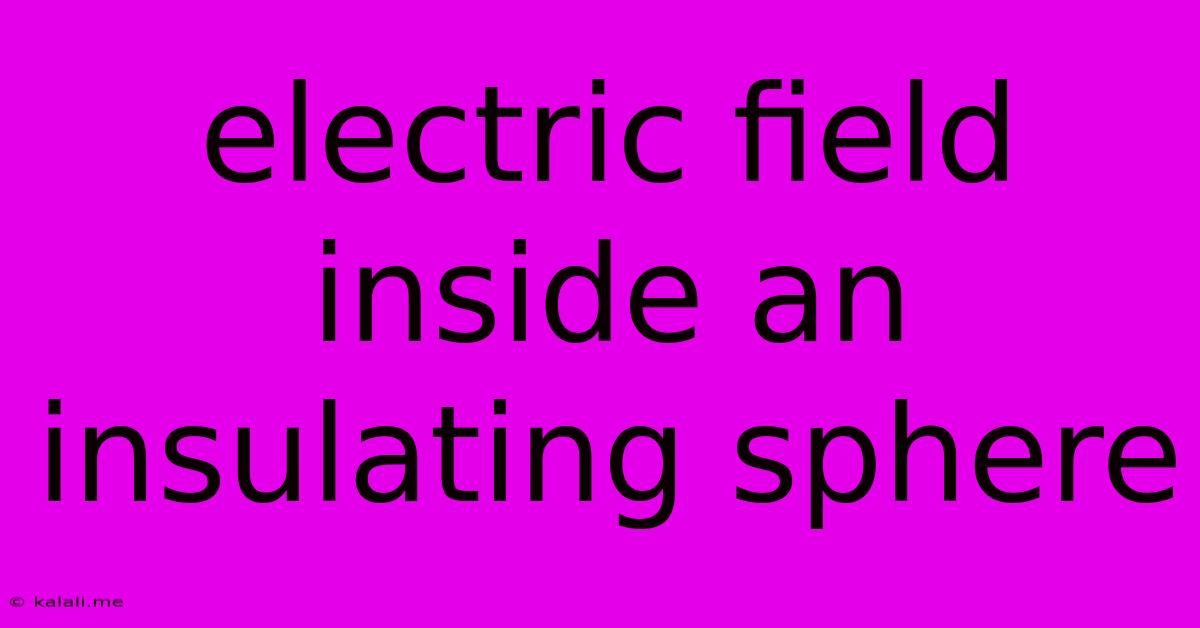Electric Field Inside An Insulating Sphere
Kalali
Jun 01, 2025 · 3 min read

Table of Contents
Electric Field Inside an Insulating Sphere: A Comprehensive Guide
Meta Description: Understanding the electric field within an insulating sphere requires knowledge of Gauss's law and the concept of charge distribution. This article provides a step-by-step explanation, including calculations and real-world applications.
The electric field inside an insulating sphere is a fundamental concept in electrostatics with significant applications in various fields, including material science and electrical engineering. Unlike conductors where charges reside on the surface, insulators possess a volume charge density, meaning charges are distributed throughout the material. This distribution significantly impacts the electric field's behavior within the sphere. This article will delve into the calculation and understanding of this electric field.
Understanding Charge Distribution in Insulators
Before we delve into the calculation of the electric field, it's crucial to understand how charge is distributed within an insulating sphere. Unlike conductors, where charges arrange themselves to cancel out any internal electric field, charges in an insulator are fixed in position. This often results in a non-uniform charge density, denoted by ρ (rho), which can be a function of the radial distance (r) from the center. However, for simplicity and common scenarios, we'll often assume a uniform volume charge density. This assumption greatly simplifies our calculations while providing a valuable conceptual understanding.
Applying Gauss's Law
To determine the electric field inside the sphere, we'll employ Gauss's law, a cornerstone of electromagnetism. Gauss's law states that the flux of the electric field through a closed surface is proportional to the enclosed charge. Mathematically, this is represented as:
∮ E • dA = Q<sub>enc</sub> / ε₀
where:
- E is the electric field vector
- dA is a differential area vector
- Q<sub>enc</sub> is the enclosed charge
- ε₀ is the permittivity of free space
For our insulating sphere, we'll choose a spherical Gaussian surface with radius r (where r < R, and R is the radius of the insulating sphere) concentric with the insulating sphere. This choice simplifies the calculation significantly because the electric field will be radially symmetric.
Calculation of the Electric Field
Since the electric field is radial, the dot product in Gauss's law simplifies. The enclosed charge, Q<sub>enc</sub>, is the volume charge density (ρ) multiplied by the volume of the Gaussian sphere (4/3πr³):
Q<sub>enc</sub> = ρ * (4/3πr³)
Substituting this into Gauss's law and considering the symmetry, we get:
E * 4πr² = ρ * (4/3πr³) / ε₀
Solving for the electric field (E), we obtain:
E = (ρr) / (3ε₀)
This equation reveals that the electric field inside a uniformly charged insulating sphere is directly proportional to the radial distance (r) from the center. This means the electric field increases linearly from zero at the center to a maximum value at the surface of the sphere (r=R). At the center (r=0), the electric field is zero.
Beyond Uniform Charge Density
While the uniform charge density case provides a clear and understandable example, real-world insulators often exhibit non-uniform charge distributions. In such cases, the charge density ρ becomes a function of r (ρ(r)), making the calculation more complex. This often requires integration to determine the enclosed charge within the Gaussian surface for each point within the sphere.
Applications and Significance
Understanding the electric field inside an insulating sphere has practical applications in various fields:
- Dielectric Materials: Insulating materials (dielectrics) are crucial components in capacitors and other electrical devices. Knowing the internal electric field helps in designing and optimizing these devices.
- Medical Imaging: The principles of electric fields within insulators are relevant to certain medical imaging techniques.
- Material Science: Studying the electric field within insulating materials helps researchers understand their physical properties and behavior.
In conclusion, calculating and understanding the electric field inside an insulating sphere is a fundamental exercise in electrostatics. While the uniform charge density case provides a simplified, yet insightful, model, the general principles and methodology can be extended to more complex scenarios with varying charge distributions. The insights gained are essential for comprehending the behavior of insulators and their applications in various technological fields.
Latest Posts
Latest Posts
-
How To Wire A 2 Pole Gfci Breaker Without Neutral
Jun 03, 2025
-
Wiring For Ceiling Fan With Two Switches
Jun 03, 2025
-
Changing 15 Amp To 20 Amp Breaker
Jun 03, 2025
-
Thunderbolt Display Monitor Macbook Pro 2019 Disconnects Randomly
Jun 03, 2025
-
How To Remove A User From A Group In Linux
Jun 03, 2025
Related Post
Thank you for visiting our website which covers about Electric Field Inside An Insulating Sphere . We hope the information provided has been useful to you. Feel free to contact us if you have any questions or need further assistance. See you next time and don't miss to bookmark.